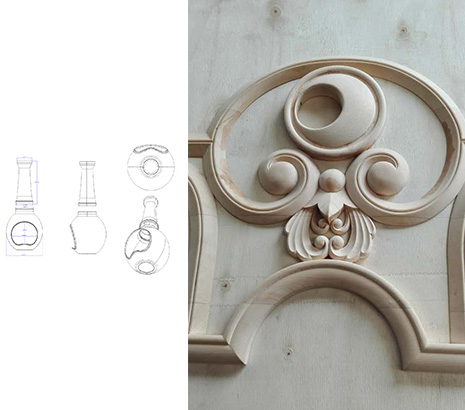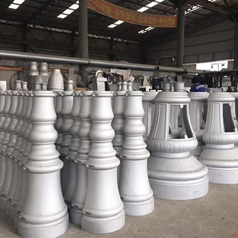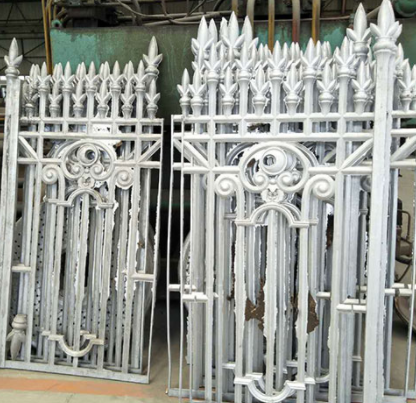Shrinkage and shrinkage are common casting defects in foundry production. Shrinkage is a pore that shrinks during the condensation process and cannot be replenished with a metal solution. It has an irregular shape and a rough wall, and is generally located at the hot joint of the casting. Shrinkage and stomata are often very similar in appearance and are often easily confused. Generally speaking, the inner wall of the pores is smooth, while the inner wall of the shrinkage pores is the tip of a branched crystal.
(A) Open shrinkage (b) Angle shrinkage (c) Core shrinkage (d) Internal shrinkage
Shrinkage is the formation of scattered and fine pores in the last solidified area of the casting without the shrinkage of the metal solution. It often appears at the thicker sections of the casting and at the junctions or thick nodes of the thick and thin sections. The shrinkage distribution area is much larger than the shrinkage holes, and it is often hidden inside the casting, sometimes not visible to the naked eye. Shrinkage and shrinkage account for a large proportion of casting waste, and must be paid enough attention to improve the qualification rate of castings.
China street lighting cast part supplier combined with many years of production practice experience, talk about the causes and preventive measures of shrinkage and shrinkage of castings.

Gravity Casting Tooling Design
1.Gravity casting tooling design
(1) Excessive change in cross-section dimensions of castings. If the size of the casting section changes too much in the design, the cooling speed of the thin section is much faster than the condensation speed of the adjacent thick section, which makes it difficult to achieve the sequential solidification of the casting and it is also difficult to perform shrinkage. Try to avoid this situation when designing, otherwise cold iron should be used to achieve the order solidification of the casting and facilitate shrinkage.
(2) The cross section of the casting is too thick. If no corresponding measures are taken to replenish it, it will cause shrinkage due to poor replenishment.
(3) The fillet is too small. The concave corner fillet radius of the casting is too small, which will reduce the heat transfer capacity of the molding sand and the solidification speed. At the same time, the molding sand has a strong heating effect and a high gas pressure. Gas shrinkage.
(4) The fillet is too large. If the fillet is too large, the fillet will become a thick section. If the adjacent section is thin, it will be difficult to obtain effective shrinkage, resulting in poor shrinkage.
2. Look
(1) The wear of the pattern or the core box results in a thinner section of the casting, which results in a thinner section thickness of the casting and hinders the shrinkage.
(2) The improper size or improper structure of the pattern results in excessively thick or thin sections. When designing, pay attention to control the thickness of the pattern, and try to keep the thin section adjacent to the thicker section to the maximum thickness.
3.Sandbox
(1) The loading case is too shallow. In order to save the amount of sand in production or to reduce the cost of the sand box and the molding, the use of an insufficiently high top box is a common cause of shrinkage defects. Too shallow a box will reduce the static pressure of the liquid metal, making it difficult to perform shrinkage. The insufficient shrinkage pressure will cause shrinkage or shrinkage, or both. If you have to use a shallow top box, you should use a riser sleeve or a pouring cup to compensate for the problem caused by the shallow top box. You can also use a heating riser or continuously add metal liquid to the riser To improve the efficiency of filling.
(2) The sand box is too small. In order to save molding sand and reduce costs, an under-sized sand box shape is sometimes used. The size of the flask is too small, which will affect the reasonable arrangement of the pouring system or cause the riser to be too close to the wall of the flask. The metal liquid in the riser will cool and solidify prematurely before completing the filling. Try to use heating riser and rain gate to solve these problems.
(3) The case is not suitable. Due to the inconsistent size of the box cover, the sand mold cannot be supported well, which results in displacement or deformation of the mold wall, forming a thicker casting section, so that the original design of the riser is insufficient to supplement it.
 How To Solve The Burr Of Aluminum Castings
Jul. 29, 2024
How To Solve The Burr Of Aluminum Castings
Jul. 29, 2024
 Aluminum Casting 4 Kinds Of The Surface Treatment Pr...
Jul. 09, 2024
Aluminum Casting 4 Kinds Of The Surface Treatment Pr...
Jul. 09, 2024
Copyright © Dalian Lianjiang Metal Co., Ltd. All Rights Reserved | Sitemap
Recommend Products: Aluminum Mailbox With Post
